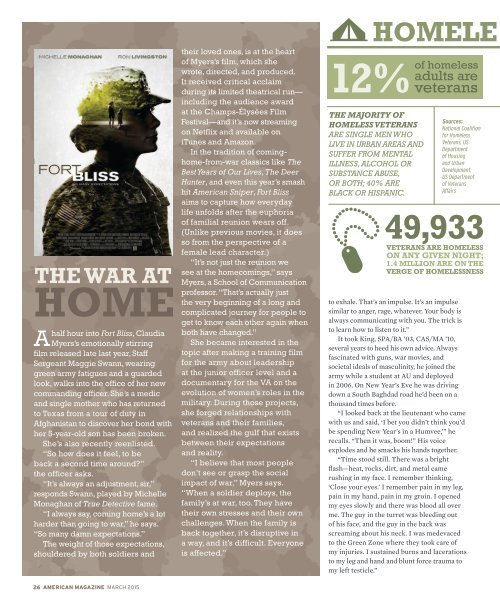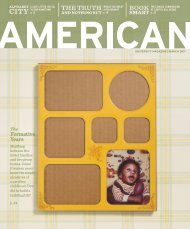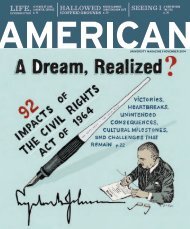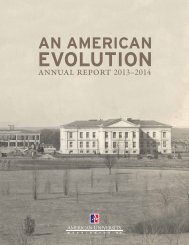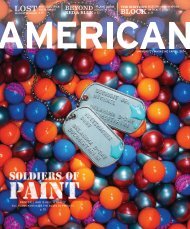American Magazine March 2015
This issue, meet DC Mayor Muriel Bowser, learn about the influx of post-9/11 veterans on college campuses across the country, hop on the Metro to Farragut North, and get to know some of AU's 600 Phoenix transplants. Also in the March issue: the psychology behind selfies, attorney Tom Goldstein's path to the Supreme Court, and cartoonist Tony Rubino's tools of the trade.
This issue, meet DC Mayor Muriel Bowser, learn about the influx of post-9/11 veterans on college campuses across the country, hop on the Metro to Farragut North, and get to know some of AU's 600 Phoenix transplants. Also in the March issue: the psychology behind selfies, attorney Tom Goldstein's path to the Supreme Court, and cartoonist Tony Rubino's tools of the trade.
Create successful ePaper yourself
Turn your PDF publications into a flip-book with our unique Google optimized e-Paper software.
half hour into Fort Bliss, Claudia<br />
A Myers’s emotionally stirring<br />
film released late last year, Staff<br />
Sergeant Maggie Swann, wearing<br />
green army fatigues and a guarded<br />
look, walks into the office of her new<br />
commanding officer. She’s a medic<br />
and single mother who has returned<br />
to Texas from a tour of duty in<br />
Afghanistan to discover her bond with<br />
her 5-year-old son has been broken.<br />
She’s also recently reenlisted.<br />
“So how does it feel, to be<br />
back a second time around?”<br />
the officer asks.<br />
“It’s always an adjustment, sir,”<br />
responds Swann, played by Michelle<br />
Monaghan of True Detective fame.<br />
“I always say, coming home’s a lot<br />
harder than going to war,” he says.<br />
“So many damn expectations.”<br />
The weight of those expectations,<br />
shouldered by both soldiers and<br />
their loved ones, is at the heart<br />
of Myers’s film, which she<br />
wrote, directed, and produced.<br />
It received critical acclaim<br />
during its limited theatrical run—<br />
including the audience award<br />
at the Champs-Élysées Film<br />
Festival—and it’s now streaming<br />
on Netflix and available on<br />
iTunes and Amazon.<br />
In the tradition of cominghome-from-war<br />
classics like The<br />
Best Years of Our Lives, The Deer<br />
Hunter, and even this year’s smash<br />
hit <strong>American</strong> Sniper, Fort Bliss<br />
aims to capture how everyday<br />
life unfolds after the euphoria<br />
of familial reunion wears off.<br />
(Unlike previous movies, it does<br />
so from the perspective of a<br />
female lead character.)<br />
“It’s not just the reunion we<br />
see at the homecomings,” says<br />
Myers, a School of Communication<br />
professor. “That’s actually just<br />
the very beginning of a long and<br />
complicated journey for people to<br />
get to know each other again when<br />
both have changed.”<br />
She became interested in the<br />
topic after making a training film<br />
for the army about leadership<br />
at the junior officer level and a<br />
documentary for the VA on the<br />
evolution of women’s roles in the<br />
military. During those projects,<br />
she forged relationships with<br />
veterans and their families,<br />
and realized the gulf that exists<br />
between their expectations<br />
and reality.<br />
“I believe that most people<br />
don’t see or grasp the social<br />
impact of war,” Myers says.<br />
“When a soldier deploys, the<br />
family’s at war, too. They have<br />
their own stresses and their own<br />
challenges. When the family is<br />
back together, it’s disruptive in<br />
a way, and it’s difficult. Everyone<br />
is affected.”<br />
THE MAJORITY OF<br />
HOMELESS VETERANS<br />
ARE SINGLE MEN WHO<br />
LIVE IN URBAN AREAS AND<br />
SUFFER FROM MENTAL<br />
ILLNESS, ALCOHOL OR<br />
SUBSTANCE ABUSE,<br />
OR BOTH; 40% ARE<br />
BLACK OR HISPANIC.<br />
Sources:<br />
National Coalition<br />
for Homeless<br />
Veterans, US<br />
Department<br />
of Housing<br />
and Urban<br />
Development,<br />
US Department<br />
of Veterans<br />
Affairs<br />
to exhale. That’s an impulse. It’s an impulse<br />
similar to anger, rage, whatever. Your body is<br />
always communicating with you. The trick is<br />
to learn how to listen to it.”<br />
It took King, SPA/BA ’03, CAS/MA ’10,<br />
several years to heed his own advice. Always<br />
fascinated with guns, war movies, and<br />
societal ideals of masculinity, he joined the<br />
army while a student at AU and deployed<br />
in 2006. On New Year’s Eve he was driving<br />
down a South Baghdad road he’d been on a<br />
thousand times before.<br />
“I looked back at the lieutenant who came<br />
with us and said, ‘I bet you didn’t think you’d<br />
be spending New Year’s in a Humvee,’” he<br />
recalls. “Then it was, boom!” His voice<br />
explodes and he smacks his hands together.<br />
“Time stood still. There was a bright<br />
flash—heat, rocks, dirt, and metal came<br />
rushing in my face. I remember thinking,<br />
‘Close your eyes.’ I remember pain in my leg,<br />
pain in my hand, pain in my groin. I opened<br />
my eyes slowly and there was blood all over<br />
me. The guy in the turret was bleeding out<br />
of his face, and the guy in the back was<br />
screaming about his neck. I was medevaced<br />
to the Green Zone where they took care of<br />
my injuries. I sustained burns and lacerations<br />
to my leg and hand and blunt force trauma to<br />
my left testicle.”<br />
26 AMERICAN MAGAZINE MARCH <strong>2015</strong>


